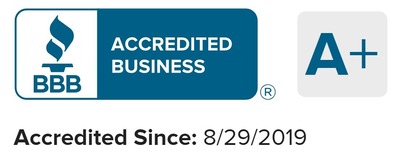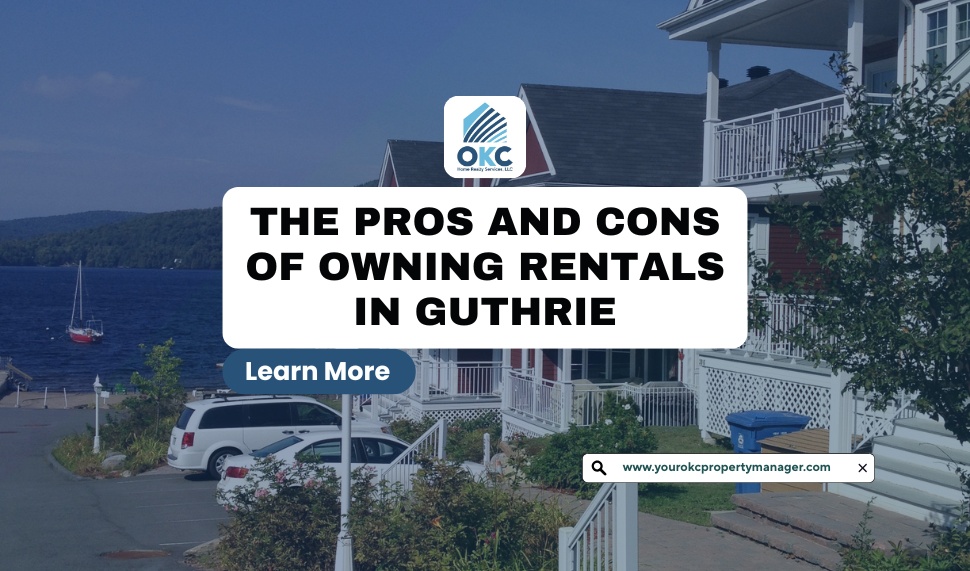Investing in rental property stands out as one of the most reliable methods to grow wealth over time. However, not every real estate market offers the same potential. While big cities like Oklahoma City or Edmond often grab the attention, smaller places such as Guthrie, Oklahoma, now catch the eye of landlords and investors. Famous for its historic center, small-town feel, and closeness to Oklahoma City, Guthrie presents special chances for rental property owners, but it also brings its own set of problems.
Having worked with property owners and managed rental properties in Oklahoma City and nearby areas for more than 15 years, I’ll break down the pros and cons of owning rentals in Guthrie, OK. This article aims to give you clear, fact-based, and useful information to help you figure out if putting your money here fits well with your other investments.
Why Guthrie? A Quick Overview
Before diving into the benefits and demerits, let’s set the stage with some context.
- Location: Guthrie sits about 30 miles north of Oklahoma City, making it part of the greater OKC metro area.
- Population: According to the World Population Review, Guthrie’s population is around 11,805 and has shown a steady growth rate of 1.76%, though not rapid growth, over the past decade.
- Economy: The town’s economy is supported by education, healthcare, manufacturing, and tourism (thanks to its historic district and cultural events).
- Housing Market: Guthrie is known for affordable housing compared to nearby Edmond and Oklahoma City, making it attractive to renters who want lower costs while staying within commuting distance of larger job centers.
With that in mind, let’s break down the advantages and disadvantages of owning rentals in Guthrie, OK.
The Pros of Owning Rentals in Guthrie
1. Affordable Entry Point for Investors
One of Guthrie’s biggest draws is its affordability.
- The median home price in Guthrie is significantly lower than in Edmond and higher than in Oklahoma City. According to Zillow data (2025), the median home price in Guthrie is around $238,000 – $240,00, compared to Edmond’s $330,000+ and Oklahoma City’s $220,000+.
- Lower acquisition costs mean investors can buy more properties or diversify their portfolio without overextending financially.
For investors just starting out or those wanting to scale with multiple units, Guthrie provides a cost-effective entry point.
2. Strong Rental Demands from Commuters
Many Guthrie renters work in Edmond or Oklahoma City but choose Guthrie for its lower cost of living and small-town lifestyle.
- The commute to downtown Oklahoma City is roughly 30–40 minutes, which is manageable for many workers.
- As housing prices rise in OKC and Edmond, more tenants look to Guthrie as a budget-friendly alternative.
This creates consistent rental demand, especially for single-family homes and starter rentals.
3. Historic Charm and Tourism Appeal
Guthrie isn’t just another small town; it’s a National Historic Landmark District. Its Victorian-era architecture, annual events (like the Guthrie Victorian Walk and Bluegrass Festival), and museums draw visitors year-round.
While most tourists don’t rent long-term housing, this atmosphere enhances Guthrie’s appeal to residents who want a community with character. Investors who purchase historic homes or properties near downtown may also benefit from strong appreciation potential.
4. Lower Vacancy Rates than Expected
Despite being a smaller town, Guthrie has relatively healthy occupancy rates. According to U.S. Census data, the rental vacancy rate in Logan County (where Guthrie is located) typically ranges between 5–7%, which is lower than the national average in some years.
This suggests that landlords in Guthrie don’t struggle as much to keep units filled compared to rural areas with less commuter access.
5. Landlord-Friendly State Laws
Oklahoma is generally considered a landlord-friendly state, and Guthrie landlords benefit from this.
- Eviction processes are relatively straightforward compared to tenant-favored states.
- Property taxes remain low, averaging 0.88% of assessed home value, which is below the national average.
This legal and financial environment makes Guthrie attractive to both in-state and out-of-state investors.
6. Potential for Long-Term Appreciation
While Guthrie’s appreciation rates have historically been slower than Edmond’s or Oklahoma City’s, the area is beginning to benefit from OKC’s outward growth. As more people move north for affordability, property values in Guthrie are expected to rise gradually.
For investors with a buy-and-hold strategy, this means potential long-term equity gains alongside rental income.
The Cons of Owning Rentals in Guthrie
1. Limited Tenant Pool
While there is demand, Guthrie’s population size limits the tenant base compared to larger cities. With fewer people moving in, landlords may face longer wait times to find tenants, especially for properties priced above the local average rent.
This makes tenant screening even more critical; vacancies can eat into profits quickly in smaller markets.
2. Lower Rent Prices Compared to Edmond or OKC
Affordability is a double-edged sword. While homes are cheaper, rents are also lower.
- The average rent for a 3-bedroom home in Guthrie is around $1,100–$1,300 per month (as of 2025).
- By comparison, Edmond averages closer to $1,600–$1,800 per month for similar homes.
This means cash flow per unit may be smaller in Guthrie, making it less appealing for investors focused solely on monthly income.
3. Slower Appreciation Rates
Unlike booming suburban areas, Guthrie has historically experienced modest appreciation. While that’s starting to change, investors expecting rapid growth may be disappointed.
Guthrie is better suited for steady, long-term investments rather than quick flips or high-growth strategies.
4. Older Housing Stock and Maintenance Costs
Many of Guthrie’s homes are older, especially near the historic district. While these properties have charm, they can also bring challenges:
- Outdated electrical and plumbing systems
- Higher maintenance costs
- Potential lead paint or asbestos in very old structures
- Compliance with historical preservation rules (if applicable)
Investors must budget more for repairs and renovations compared to newer developments in Edmond or OKC suburbs.
5. Economic Dependence on Nearby Cities
Guthrie doesn’t have the same level of job diversity as Oklahoma City or Norman. Many residents commute elsewhere for work.
If employment opportunities shrink in Edmond or OKC, Guthrie could feel the ripple effects more strongly, which may impact rental demand and tenant stability.
6. Smaller Pool of Property Management Companies
If you’re an out-of-state investor, managing rentals in Guthrie can be trickier. Unlike OKC or Edmond, which have dozens of property management firms, Guthrie has fewer local options.
This could mean:
- Less competition (higher management fees)
- Limited services
- Fewer specialized managers for multi-family or short-term rentals
For hands-off investors, this is a factor worth considering.
Comparing Guthrie to Nearby Markets
To put Guthrie into perspective, here’s a quick comparison with nearby areas:
| Market | Median Home Price (2025) | Average Rent (3-BR) | Vacancy Rate | Investment Profile |
| Guthrie | $180,000 | $1,100-$1,300 | 5-7% | Affordable entry, steady demand |
| Edmond | $330,000 | $1,600-$1,800 | 4-5% | Higher appreciation |
| OKC | $220,000 | $1,400-$1,600 | 6-8% | Diverse economy, broader demand |
| Norman | $250,000 | $1,400-$1,700 | 5-6% | College-town demand, stable rental base |
This snapshot shows Guthrie’s unique position: affordable and steady but slower-growing compared to surrounding hotspots.
Who Should Invest in Guthrie Rentals?
Guthrie isn’t the right fit for every investor. Here’s a breakdown of who might benefit most:
- Buy-and-hold investors who want steady cash flow and gradual appreciation.
- New investors looking for a lower-cost entry into real estate.
- Local landlords who can self-manage and handle maintenance issues directly.
- Investors who value stability over rapid growth.
However, if your strategy relies on high rental yields, quick appreciation, or large tenant pools, you may find better opportunities in Edmond, OKC, or Norman.
Tips for Success in Guthrie’s Rental Market
If you decide Guthrie is right for you, here are some practical tips:
- Run conservative cash flow projections. Don’t overestimate rent; use realistic averages.
- Budget extra for maintenance. Especially if you’re buying older homes.
- Screen tenants carefully. With a smaller tenant pool, finding reliable renters is crucial.
- Consider commuter-friendly locations. Properties with quick access to I-35 appeal most to Edmond/OKC commuters.
- Build local vendor relationships. Since property management options are limited, reliable contractors and repair services are essential.
Is Owning Rentals in Guthrie Worth It?
Your objectives determine the answer. Guthrie doesn’t offer a market where investors can expect rapid growth or extremely high rents. Rather, it provides a consistent, budget-friendly, and reliable market with steady rental demand from commuters looking to cut housing expenses.
Advantages: Affordable entry costs, ongoing demand, landlord-friendly laws, and long-term reliability.
Disadvantages: Limited pool of tenants, gradual appreciation of lower rental income, and increased upkeep for older properties.
Guthrie might be a wise investment if you want a low-cost option with dependable returns over time. But, if your aim is to maximize cash flow or see quick increases in property value, you might find markets like Edmond or OKC more suitable for your investment plan.

Author
Scott Nachatilo is an investor, property manager and owner of OKC Home Realty Services – one of the best property management companies in Oklahoma City. His mission is to help landlords and real estate investors to manage their property in Oklahoma.
 (
(









